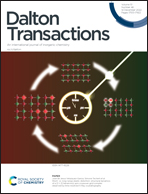Zinc(ii) complexes of 3-bromo-5-chloro-salicylaldehyde: characterization and biological activity†
Abstract
Five neutral zinc(II) complexes of 3-bromo-5-chloro-salicylaldehyde (3-Br-5-Cl-saloH) were synthesized in the absence or presence of the nitrogen-donor co-ligands 2,2′-bipyridine (bipy), 1,10-phenanthroline (phen), 2,9-dimethyl-1,10-phenanthroline (neoc), or 2,2′-bipyridylamine (bipyam) and were characterized by various techniques. The obtained complexes were [Zn(3-Br-5-Cl-salo)2(H2O)2] (1), [Zn(3-Br-5-Cl-salo)2(bipy)] (2), [Zn(3-Br-5-Cl-salo)2(phen)] (3), [Zn(3-Br-5-Cl-salo)2(neoc)] (4) and [Zn(3-Br-5-Cl-salo)2(bipyam)] (5). The crystal structures of complexes 1 and 3 were determined by single-crystal X-ray crystallography. The interaction of the compounds with calf-thymus DNA takes place via intercalation. The compounds may moderately cleave pBR322 plasmid DNA at a concentration of 500 μM. The compounds may bind tightly and reversibly to serum albumins. The antioxidant activity of the compounds was examined towards 1,1-diphenyl-picrylhydrazyl and 2,2′-azinobis(3-ethylbenzothiazoline-6-sulfonic acid) radicals and H2O2. The antimicrobial potency of the compounds was investigated against Staphylococcus aureus ATCC 6538, Bacillus subtilis ATCC 6633, Escherichia coli NCTC 29212 and Xanthomonas campestris ATCC 1395.

- This article is part of the themed collection: Spotlight Collection focused on Inorganic Chemistry in Greece


 Please wait while we load your content...
Please wait while we load your content...